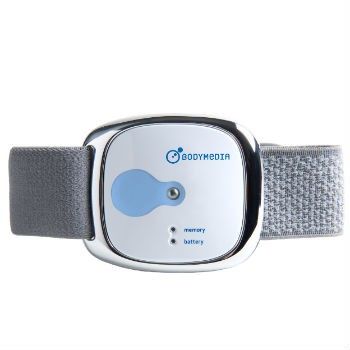There are all sorts of pedometers and heart rate monitors on the market meant to help us lead healthier lives. BodyMedia Armbands sets out to help people meet health and wellness goals by measuring all sorts of stuff (like calorie burn and sleep quality, for starters). I tried out the BodyMedia LINK Bluetooth-enabled armband, courtesy of BodyMedia, a company that makes wearable body monitoring systems to help people manage and lose weight. Find out how it tracks, what it tracks, and the technology that makes it better than some other devices.
What It Does
There are three parts to the BodyMedia LINK: the armband, the Bluetooth enabled smartphone app, and the online software tool. The armband records data like skin temperature, motion, sweat, and steps taken with a sensor that touches the skin of the user’s arm (more on this later). This info heads straight to the user’s smartphone or computer (via USB).
The big selling point of this armband is that it can measure more than most other toss-in-a-pocket, bracelet, or clip-on devices, like the Fitbit or the Jawbone UP, because it’s in direct contact with the skin. One of the coolest features that sets this tracker apart is that it also provides a sleep efficiency score based on how long it takes the wearer to fall asleep, and the user’s sleep-wake cycle throughout the night.
How it Works
The armband, which can be worn for up to 23 hours a day, collects data from the four sensors that remain in contact with the user’s upper arm. The sensors measure four things: galvanic skin response (when a person sweats, the skin becomes more electrically conductive), skin temperature, heat flux (the rate heat dissipates from the body), and motion/steps taken. BodyMedia’s algorithm analyzes the info along with the user’s weight, height, and age to pump out calorie burn, activity level, steps taken, and sleep efficiency. The app and online software also have a food database where users can log meals and snacks (aka energy consumed).
The BodyMedia LINK determines lying down and sleep time by picking up things like motion and temperature. Then the software uses all sorts of fancy-schmancy algorithms to analyze the data and package it into a sleep score.
Downside
There were no horrible downsides to the BodyMedia LINK. If anything, the most annoying downside of this device is that it’s worn on the arm and isn’t easy to hide under most shirts, but the benefits of the on-skin technology may trump the unsightly lump. The band was slightly uncomfortable when I wore it nearly all day and night, but it’s certainly not mandatory to wear so many hours at a time (wearing it more often just means a more accurate overall picture). Another downfall is the monthly subscription fee for the online software ($6.95 per month for 12 months, or $13 per month on a month-to-month basis). But in retrospect, the software pretty much pays for itself because it’s nice to be held accountable, and in the long run, using the device could theoretically save money by improving health.
While the software made the data easy to understand, I was kind of bummed with the included food database. It was easy to use, but if I wanted to get specific items (like the pumpkin butter I put in my morning oats or a specific brand of protein powder), it wasn’t very comprehensive. I was excited to see that I could sync MyFitnessPal (a free online food log), which has a massive database for a more accurate measurement of calories consumed. Finally, one nit-pick is that the device emits a not-so-discreet beeping jingle when plugged into the computer or when the sensors touch the user. This is where the included Bluetooth component (that I didn’t take advantage of) would have been useful, so as not to disrupt everyone else around me.
Verdict
BodyMedia does a lot of things right. First off, I’ve got to hand it to the battery power of this little guy. I could go days without charging it. For people who want to get the most out of the device and wear it for the majority of the day, this is a big plus. I didn’t use the Bluetooth feature (simply because I got used to plugging the device into my computer every morning to check in) but it would have been cool to check out real-time caloric burn (and other stuff).
It was fun to check out spikes in the energy burned chart and see exactly what time I was burning a specific amount of calories (8 calories per minute climbing up the stairs of my fifth-floor walk up, or 1 calorie per minute when I was sleeping). But of course it’s not all about the calories. I could see overnight spikes that reflected the night I was up with a migraine, or the lulls when I was seated at my desk. I liked checking in every day to see if I set any new personal bests. If used for more than a week, and used to its fullest potential, the BodyMedia LINK is undoubtedly one of the most inclusive trackers out there.
The BodyMedia LINK Armband is probably best suited for the dedicated tracker. It’s a little pricier than Fitbit trackers or the Nike+ FuelBand, but it’s probably worth it for it’s unique sensor technology and comprehensive results.
Have you tried a BodyMedia armband? What did you think? Let us know in the comment section below, or tweet the author @nicmcdermott.
Disclosure: All affiliate links on Greatist highlight products the team has either reviewed or thinks are kick-ass. Greatist’s editorial team is completely removed from the business side, which handles these fancy links.

